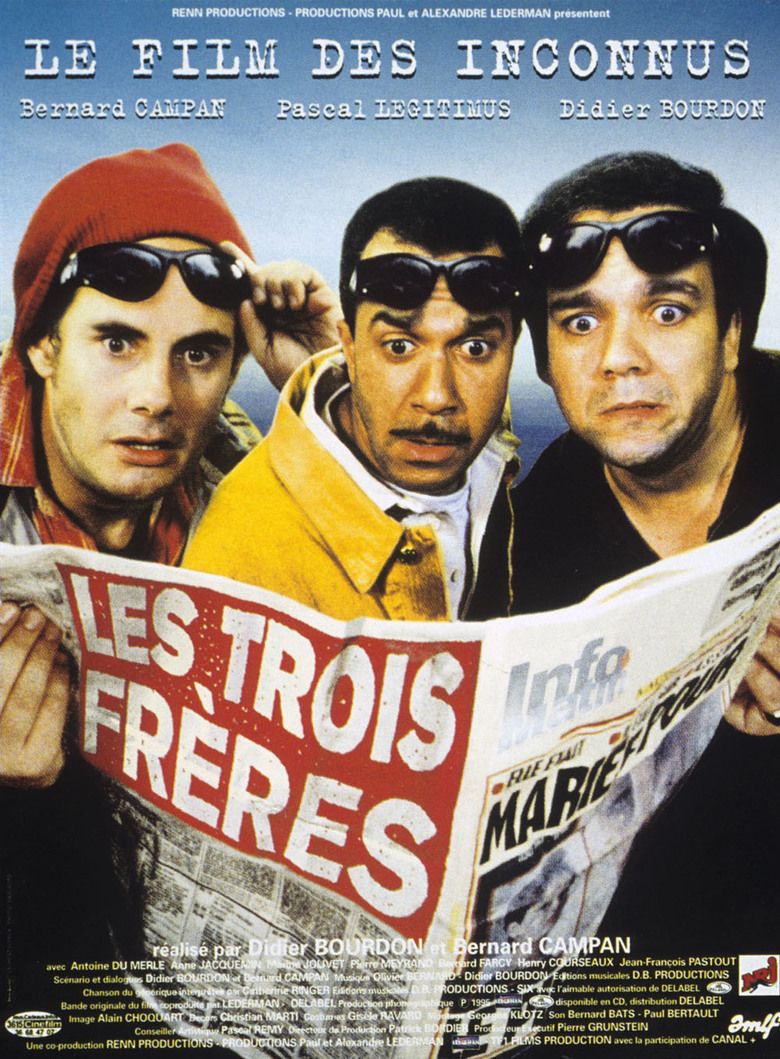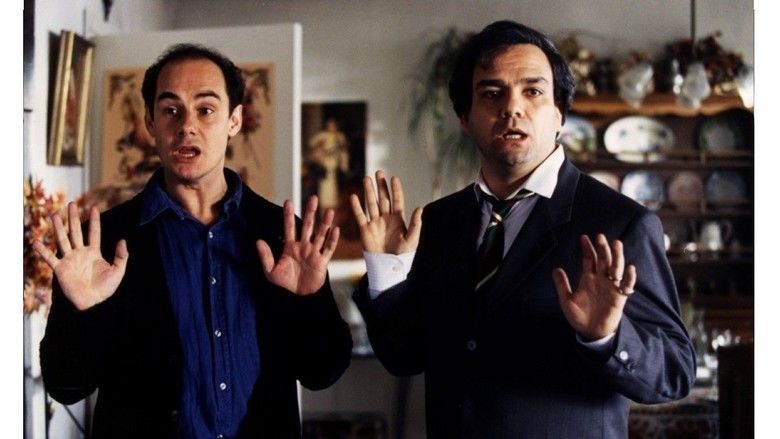Three Crowns of the Sailor
7.4 /10 1 Votes
Director Raul Ruiz | 7.2/10 IMDb Genre Drama, Fantasy Duration Country France | |||||||||||||||||||||||||||||||||
 | ||||||||||||||||||||||||||||||||||
Writer Emilio Del Solar , Francois Ede Release date 1983 (1983) Screenplay Raul Ruiz, Francois Ede, Emilio del Solar Cast Jean-Bernard Guillard (le matelot), Philippe Deplanche (l'étudiant), Jean Badin (un officier), Nadège Clair (Maria)Similar movies Directed by Raul Ruiz, French movies, Fantasy movies | ||||||||||||||||||||||||||||||||||
Three crowns of the sailor intro
Three Crowns of the Sailor (French: Les Trois couronnes du matelot) is a 1983 French fantasy film directed by Raúl Ruiz.
Contents
- Three crowns of the sailor intro
- Three crowns of the sailor ruiz 1983
- Cast
- Plot
- Themes and motifs
- Analysis
- Reception
- References

Three crowns of the sailor ruiz 1983
Cast

Plot

The film opens with a murder of a professor committed by his student in Warsaw. The black and white scene is alternately narrated by the protagonist of the film known simply as the "Sailor" and the student. The student walks through war torn Warsaw when he meets the Sailor, simply known as "The Other", who offers him an escape from the country through a boat job. They enter a bar to negotiate the deal; the student agrees to listen to his story and give him 3 crowns.

The Sailor starts his story- depicted in colored film- he is offered a job by a local swindler known as the blind man. He would later find the blind man dying on the side of the road being stabbed, yet telling him that everything that he sees is a lie. The sailor seems to brush it off and go about his final day in Valparaiso. With his departure from home, he leaves his sister and mother to work on the ship, the Funchalense. this mysterious apparition of a ship contains even stranger inhabitants. The sailors who run the ship are tattooed with solitary letters and supposedly never defecate. On one occasion, the sailor claims to have been imprisoned in another sailor's body, and as he wanders around the boat in bewilderment, encounters multiple visions of himself from this different perspective.

Those who work on the ship are able to eat and eat, yet they never defecate. There is one instance where a sailor throws himself overboard because he is tired of living on the boat, yet the next day he is back on the deck and acting as if nothing had ever happened. Those who live on the boat do not adhere to the laws of nature, as they sweat maggots and on one occasion, the sailor claims to have been imprisoned in another sailor's body, and as he wanders around the boat in bewilderment, encounters multiple visions of himself from this different perspective.

The student at multiple points throughout the sailor's story interrupts him to either question his logic or tell him that he has heard this story time and time again. His attention is slipping as he can physically see him getting drowsy and bored as he waits to escape this place from which he has recently killed someone. The student's lack of patience does not deter the sailor from his pace of progress through his tale of his life.

The story continues to unfold through the sailor's multiple docking experiences. The sailors go from port to port as they sail around the world, and in these different ports, our sailor goes on different adventures. He befriends and becomes the benefactor of a prostitute in a brothel who calls herself “The Virgin Mary”. Her room is filled with demonic looking porcelain dolls. He falls in love with an erotic dancer femme-fatale named Mathilde. She comes to haunt him for years to come after they separate due to her se desirable yet only having one orifice. In Singapore he finds the love of a small boy who is actually an old doctor thousands of years old in a youthful body, and adopts him as his son. Finally, he meets a wise man in Africa who he feels is a paternal figure and wishes to explain his life and philosophy to him, but it would take too much time to do so.
A common motif in all of the sailor’s tales is that he has to borrow money in order to go on and progress through his adventures. Before he could live a happy life with his son, his lover, his to be wife, his father, and his solitude, he must pay off all of his debts that he made on the boat. He wins most of the money that he borrowed back through a gambling game he plays with those who he is indebted too, with the exception of three Danish crowns. After the student has paid off his debts of listening to the sailor's tale and giving him the three Danish crowns, he demands his payment, and when the sailor tells him he hasn't earned the job, the student bludgeons the sailor to death. The sailor reappears on the boat as a phantom and the student understands the true price of the job. The film ends by concluding that there must be one live sailor among a boat of dead men as they sail off into the open ocean.
Themes and motifs
The film employs various film filters to imply different cinematic states. The conversation framing the epic tale of the sailor's journey is mostly denoted by a black and white filter reminiscent of film noir, while the tale itself unfolds in color.
The film employs a wide variety of cinematic techniques ranging from deep-focus shots to vertigo shots. Various shots cast attention on background elements or subdue the essential subjects with focus on details and objects in the foreground. These various framing techniques often illustrate one of the "Six Processes" of composition referenced in Ruiz's later film meditation, "Poetics of Cinema."
The cinematic style of the film evokes Ruiz's meditations on the "image-situation" and the method of propagating thought through audiovisual schemas rather than through the transparent plots prescribed by Central Conflict Theory cinema. His varied shooting style illustrates the alternative evocative method mentioned in Poetics of Cinema:
"In all these projects I seek to move from one world into another, using a technique described in baroque Venice, "Il Ponte," a way of producing anamorphic agents to play with the four levels of medieval rhetoric: literal, allegorical, ethical, and anagogical... Except that instead of seeking to read all four levels at the same time, the aim is to skip constantly from one level to another. The jump is the element of surprise that not only procures a sudden illumination, but all the pleasure as well. Imagine a slalom skier propelled with each turn not just in another direction, but on to a completely different slope. In this way he manages to travel four different journeys at once, though the point is not in the journeys themselves but in the beauty of his leap from one world to the next."
Thus, some understand these distinctive frames as "jumps" between the four levels of rhetoric, which simultaneously reminds the audience of vital diegetic and symbolic filmic elements and encourages the audience to make the critical interpretive connections these cognitive gaps generate. One term for this mode of production is "visual polysemy."
Analysis
A close look at this film will express Ruiz's feeling towards acclimating to a new lifestyle in a new country after leaving Chile in exile. The duality of the living and the dead that are represented in the film on the Funchalense are representative of the diaspora felt by those who were exiled from Chile during the Pinochet Coup abruptly ended President Salvador Allende's attempt to integrate democracy into the Chilean culture in 1973. The sailor known as "The Other" is leaving his home of Valparaiso to journey the world with a crew of dead sailors. all the crew members on the Fuchalense are unable to return to their homes, as we see with "The Other" when he returns home, and thus instead of having a nationality of where they came from, they belong to the boat. This is a symbolic representation of having to leave behind your nationality while trying to find your own in lands that are foreign to you. Ruiz takes a satirical look at the world in this film as well. The scholarly student, who questions the world around him and yet seems to know everything about the sailor's story, acts irrationally and without logic, just an impulsive being. Making the student be impulsive ties into the narrative that this film is about exile, such as the student knows why he must leave, yet he is not sure how he got to this point.
Reception
Although this is one of Ruiz's most well known films, when it was screened at the Cannes Film Festival it had one of the highest walk-out rates of a movie due to being "deliberately unsynopsizable". Despite the initial reception at the festival, this is one of Ruiz's most well credited movies, winning him the Perspectives Du Cinema award at the Cannes Film Festival Three Crowns of a Sailor may have been his most liked work among audiences, but it was Ruiz's least favorite film, due to the fact that he adhered to a conventional script, rather than creating scenes that simply wanted to exist.
References
Three Crowns of the Sailor WikipediaThe Three Brothers (film) IMDb The Three Brothers (film) themoviedb.org Three Crowns of the Sailor IMDb Three Crowns of the Sailor themoviedb.org
